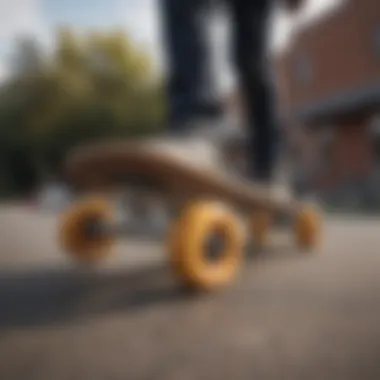Unveiling the Intricacies of Longboard Skateboards: A Comprehensive Guide


Skateboarding News Updates
Longboarding has captured the attention of thrill-seekers and sport enthusiasts globally, with new advancements and trends constantly emerging in the scene. Stay updated with the latest skateboarding competitions, where elite athletes showcase their skills and endurance in challenging environments. Keep an eye out for exciting new product launches, unveiling cutting-edge designs and technologies that push the boundaries of longboard skateboarding. Immerse yourself in the vibrant atmosphere of skateboarding events, where riders come together to celebrate their passion for this exhilarating sport.
Trick Tutorials and Guides
Embark on your longboarding journey with comprehensive tutorials breaking down beginner tricks step by step. Advance your skills with expert tips on mastering advanced tricks that test your agility and creativity. Explore the art of freestyle and street skate techniques, discovering new ways to express yourself through fluid movements and rhythm on your longboard.
Skateboarding Culture and Lifestyle
Delve into the world of influential skateboarders who are shaping the culture and lifestyle of longboarding. Discover the unique features of various skateparks, unveiling hidden gems and popular spots for riders to hone their craft. Stay ahead of the curve with insights into the latest skateboarding fashion trends, blending style and functionality for a dynamic and trendy longboarding experience.
Gear Reviews and Recommendations
Uncover in-depth reviews of skateboard decks, analyzing their construction, performance, and durability to help you make informed decisions when selecting the perfect board. Compare different types of trucks and wheels, understanding how each component influences your riding experience and style. Explore recommendations for protective gear, ensuring your safety and comfort while pushing the limits on your longboard.
Healthy Lifestyle for Skaters
Prioritize your well-being with targeted exercises designed to prevent common skateboarding injuries, strengthening key muscle groups and improving your flexibility. Enhance your performance with specialized fitness and strength training tailored for skateboarders, optimizing your physical condition for challenging rides. Fuel your body with essential nutrition tips catered to skaters, providing the energy and nutrients required to sustain your active lifestyle on and off the longboard.
Introduction to Longboard Skateboards
In this section, we delve into the fascinating world of longboard skateboards, setting the stage for an in-depth exploration of this exhilarating hobby. Longboard skateboarding has gained immense popularity in recent years, offering riders a unique and thrilling experience that sets it apart from traditional skateboarding. Understanding the nuances of longboard skateboards is crucial for enthusiasts looking to dive into this dynamic sport.
Defining Longboard Skateboards
Longboard skateboards are characterized by their elongated deck, which distinguishes them from the smaller and more maneuverable standard skateboards. These boards are specifically designed for cruising, carving, and getting around with greater stability and ease. Their length offers riders a more comfortable stance and smoother ride, making them ideal for long-distance journeys and leisurely rides along scenic routes.
History and Evolution


The history of longboard skateboards traces back to the 1950s in Hawaii, where surfers sought to replicate the feeling of riding waves on land. Over the years, longboarding has evolved from a niche pastime to a global phenomenon, with enthusiasts exploring new styles, techniques, and innovations. The evolution of longboard skateboards reflects a fusion of creativity, craftsmanship, and technological advancements that have propelled the sport to new heights of popularity and diversity.
Popularity and Community
The popularity of longboard skateboarding transcends geographical boundaries, drawing in a vibrant community of riders united by their passion for the sport. From urban streets to winding mountain roads, longboarders can be found carving out their paths and pushing the boundaries of what is possible on a board. The sense of camaraderie and shared experiences within the longboarding community fosters growth, collaboration, and a deep appreciation for the artistry and skill involved in mastering this dynamic sport.
Types of Longboard Skateboards
In the realm of longboard skateboards, understanding the various types plays a pivotal role in enhancing one's riding experience. These diverse categories cater to different styles, preferences, and terrains, offering riders a spectrum of choices to match their skills and ambitions. Whether you are keen on cruising along boardwalks, executing freestyle tricks, racing down steep hills, graceful dancing maneuvers, or adventurous freeriding expeditions, the type of longboard you select significantly influences your performance and enjoyment.
Cruisers
Cruisers, a quintessential type of longboard skateboard, are characterized by their compact size, maneuverability, and ease of transportation. Ideal for navigating busy urban streets or college campuses, cruisers offer a smooth and stable ride, making them a popular choice for commuters and casual riders. With shorter decks and softer wheels, cruisers excel in short-distance travels, sharp turns, and quick accelerations, providing riders with a versatile option for everyday use.
Freestyle
Freestyle longboards epitomize creativity and expression, designed for riders who thrive on dynamic tricks, spins, and flips. Featuring symmetrical shapes, kicktails, and responsive trucks, freestyle boards empower riders to showcase their agility and skill through intricate maneuvers and stylish stunts. Whether practicing flatland tricks in a parking lot or competing in freestyle events, these boards offer ample flexibility, responsiveness, and control, allowing riders to push their boundaries and craft their unique identity within the longboarding community.
Downhill
For thrill-seekers and speed enthusiasts, downhill longboards are the ultimate adrenaline-inducing companions, built for high-speed descents and intense racing competitions. With longer decks, low centers of gravity, and precise components, downhill boards deliver stability, speed, and control on steep slopes and winding roads. Riders of downhill longboards embrace the challenge of taming gravity, mastering speed wobbles, and achieving breakneck velocities, making this discipline a test of courage, skill, and strategic precision.
Dancing
Dancing longboards embody grace, rhythm, and fluidity, inviting riders to embark on a mesmerizing ballet on wheels. Crafted with extended decks, responsive trucks, and grippy wheels, dancing boards enable performers to execute intricate footwork, spins, and slides with finesse and elegance. Whether gliding across a sunlit esplanade or participating in choreographed routines, dancers on longboards showcase their artistic flair, balance, and coordination, transforming streets into stages and maneuvers into moments of beauty and poise.
Freeride
The freeride longboarding discipline embraces versatility, exploration, and adventure, weaving together elements of downhill racing, freestyle tricks, and cruising comforts. Riders who opt for freeride boards immerse themselves in a dynamic blend of carving through curves, sliding with finesse, and conquering diverse terrains with ease. With medium-sized decks, soft to medium wheels, and responsive trucks, freeride longboards provide riders with a balanced platform to conquer hills, parks, and streets while honing their skills and expanding their horizons within the longboarding community.


Components of a Longboard
In the realm of longboard skateboarding, comprehending the components of a longboard holds paramount significance. The composition of a longboard significantly impacts its performance, maneuverability, and durability, making it essential to delve into its core elements. Understanding these components provides riders with a deeper insight into how each part contributes to the overall functionality of the longboard.
Deck
The deck of a longboard serves as its foundation, offering riders a platform to stand on while cruising or performing tricks. It plays a pivotal role in determining the stability and control of the longboard. Deck materials vary from traditional maple wood to innovative composite materials, each carrying distinct characteristics in terms of flexibility, weight, and responsiveness. When selecting a deck, riders must consider their riding style, as well as the desired level of flex and concave that best suits their preferences.
Trucks
Trucks are the metal components mounted underneath the deck that hold the wheels in place. They are crucial for steering and maintaining stability while riding. When it comes to trucks, factors such as width, height, and bushing hardness come into play, influencing how the longboard responds to turns and maneuvers. Choosing the right trucks is essential for achieving the desired level of responsiveness and control during rides, making it a key consideration for longboard enthusiasts.
Wheels
Wheels are an integral part of a longboard, directly affecting its speed, grip, and ride smoothness. Longboard wheels vary in diameter, durometer (hardness), and shape, catering to different riding styles and terrains. Riders looking to cruise long distances may opt for larger, softer wheels for comfortable rides, while those inclined towards freestyle tricks may prefer smaller, harder wheels for enhanced maneuverability. Deciding on the appropriate wheels involves considering factors like terrain conditions, desired speed, and personal riding preferences.
Bearings
Bearings are small metal rings placed inside the wheels that enable them to spin freely. They significantly impact the speed and performance of the longboard. Choosing high-quality bearings enhances the smoothness and efficiency of rides, reducing friction and allowing for higher speeds. Riders should pay attention to the ABEC rating of bearings, which indicates their precision and tolerance levels. Opting for bearings with a higher ABEC rating ensures smoother rides and improved overall performance on the longboard.
Choosing the Right Longboard
To truly immerse oneself in the exhilarating world of longboarding, selecting the appropriate longboard is not just essential but pivotal. The skater's experience, performance, and safety are intricately linked to this decision. Choosing the right longboard involves a meticulous consideration of various elements that dictate the board's suitability to the rider's needs and preferences. From the riding style to the rider's skill level, each aspect plays a crucial role in this selection process. Notably, the right longboard can enhance maneuverability, speed, and overall control. By understanding the nuances of picking the ideal longboard, riders can optimize their experience and elevate their performance on the board.
Riding Style Considerations
When delving into the realm of longboarding, one must first identify their preferred riding style. Whether it's cruising through scenic routes, mastering complex tricks, speeding down steep hills, or engaging in graceful dance-like movements, each style demands specific board characteristics to complement it. From soft flex for flowing dance moves to sturdy stability for downhill speed demons, the right longboard ensures the rider's comfort and proficiency in executing their chosen style effortlessly. Understanding these considerations allows riders to align their board selection with their desired longboarding experience, fostering a deeper connection between skater and board.
Length and Shape


The length and shape of a longboard are crucial determinants of its performance and suitability for the rider. Longer boards offer increased stability and control, fostering a smoother ride on varied terrains. Conversely, shorter boards prioritize maneuverability and agility, making them ideal for tight turns and tricks. The board's shape further enhances its functionality, with pintails excelling in carving and cruising, while kicktails are conducive to sharp turns and advanced tricks. By considering the interplay between length and shape, riders can pinpoint the board that harmonizes with their skill level, riding style, and terrain preferences, paving the way for a personalized and rewarding longboarding experience.
Flexibility and Stability
Balancing flexibility and stability is a fundamental aspect of choosing the right longboard. Flexibility influences the board's responsiveness and energy transfer, contributing to smoother turns and enhanced performance in freestyle disciplines. Meanwhile, stability is essential for high-speed descents and maintaining control over rough surfaces. Finding the optimal balance between these two elements ensures that the board adapts seamlessly to the rider's movements while maintaining steady footing, thus amplifying the overall riding experience. By attending to the delicate equilibrium between flexibility and stability, riders can harness the full potential of their longboard across diverse riding scenarios.
Wheel Size and Durometer
The size and durometer of longboard wheels significantly impact the ride quality, speed, and versatility of the board. Larger wheels exhibit greater rolling momentum and smoother navigation over bumps and cracks, ideal for long-distance cruising and downhill racing. In contrast, smaller wheels offer enhanced maneuverability and acceleration, facilitating quick turns and technical tricks. Durometer, measuring wheel hardness, influences grip and shock absorption, vital for ensuring traction and stability during high-speed rides. By scrutinizing wheel size and durometer alongside riding preferences, riders can fine-tune their longboard setup to align with their desired performance metrics, refining their longboarding prowess with precision and purpose.
Maintenance Tips for Longboards
As we dive deeper into the realm of longboard skateboards, it becomes imperative to understand the crucial aspect of maintaining these prized possessions. The maintenance tips for longboards play a pivotal role in ensuring the longevity and optimal performance of your board, making it a topic of utmost importance in this comprehensive guide.
Among the key elements of maintenance tips for longboards is the regular cleaning and lubrication of essential components. By keeping your board clean and adequately lubricated, you not only enhance its lifespan but also ensure smoother rides and better maneuverability. Proper cleaning helps prevent dirt and debris buildup, which can affect the overall performance of your longboard.
When delving into the realm of cleaning and lubrication, it is essential to use the right cleaning agents and lubricants specifically designed for longboard maintenance. Avoid harsh chemicals that can damage the components of your board and opt for gentle yet effective solutions. Regular cleaning sessions should be part of your longboarding ritual to maintain peak performance and agility.
Moving on to checking for wear and tear, this aspect of maintenance is all about proactive care and vigilance. Regularly inspecting your longboard for any signs of wear, such as cracks, dents, or loose parts, is crucial for safety and performance. Detecting issues early on can prevent further damage and costly repairs.
When checking for wear and tear, pay close attention to the deck, trucks, wheels, and bearings. Look for any signs of damage or irregularities that may compromise the stability and functionality of your longboard. Addressing any issues promptly not only ensures your safety while riding but also extends the lifespan of your board.
In essence, maintenance tips for longboards are a fundamental aspect of longboarding culture, emphasizing the value of regular care and attention to detail. By incorporating proper cleaning practices and vigilant inspections into your routine, you can enjoy a seamless and exhilarating longboarding experience while protecting your investment in this thrilling sport.
Safety Precautions
Longboarding, as exhilarating as it is, comes with inherent risks that demand careful attention to safety precautions. It is crucial to prioritize safety to prevent accidents and injuries that could hamper the enjoyment of this thrilling sport. By adhering to safety protocols, riders can ensure a secure and fulfilling longboarding experience. Fundamental safety measures include wearing protective gear and choosing safe locations for riding.
Protective Gear
When it comes to protective gear, riders must not underestimate its importance. Wearing a helmet is non-negotiable; it safeguards the head from severe injuries in the event of falls or collisions. Additionally, knee and elbow pads are essential to protect joints from abrasions and fractures. Proper footwear with good grip enhances stability, reducing the risk of slipping off the board. High-quality gloves can prevent hand injuries, particularly during slides and maneuvers.
Choosing Safe Locations
Selecting suitable locations for longboarding is paramount for ensuring rider safety. Smooth, well-maintained roads with minimal traffic are ideal for uninterrupted rides. Avoiding congested areas, steep slopes, or uneven terrain can mitigate the chances of accidents. It is advisable to familiarize oneself with local regulations regarding longboarding in public spaces to prevent legal issues. Weather conditions should also be taken into account; wet or icy surfaces increase the likelihood of slipping and losing control of the board.







